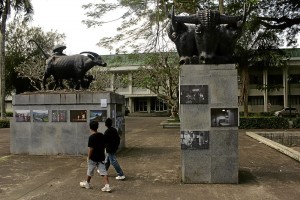
STUDENTS and passersby look at the photographs in the open-air exhibit of Quadro at the University of the Philippines in Los Baños, Laguna. MARICAR P. CINCO
Tired of fast-paced city life, a group of seasoned photographers now have sprawling mountains, a vast lake, a university and bucolic towns for subjects that tell much about the unique “spirituality” of southern Luzon.
Los Baños-based photographers have formed Quadro, a photo collective that captures and documents scenes from the province. The group’s original members are photojournalist Alex Baluyut, 56; travel photographer Al Benavente, 39; conceptual photographer Chris Quintana, 33; and street photographer Clifford Nuñez, 29. (Benavente and Quintana are both working at the International Rice Research Institute.)
Visual journalist Rocel Ann Junio, 24, later joined the pack.
“It is a community-based, small town art movement that captures the very rich and profound religiosity, cultural activities and heritage (of Southern Tagalog),” Baluyut said.
‘Decentralizing’ photography
With a collection of 25 photos of diverse subjects, Quadro opened its first open-air exhibit on Dec. 7, mounting waterproofed images at the Carabao Park near the entrance of the University of the Philippines Los Baños. The exhibit runs until Dec. 22.
“There are no quick and fast rules (in the group). We expand our work and express ourselves to make (the photos) more compelling and interesting to people,” said Baluyut, who just moved in from Manila in February.
Quintana’s works, for instance, included photographs of a community along the Laguna lake, while Junio’s captured moments from bars outside the university. Baluyut presented a “documentary” of his family finding its new home in the rustic town.
Quadro aims at tapping the rich pool of talents, especially of the younger and passionate photographers, in the provinces.
“It could be very tiring to keep on seeing the works of photographers from Manila. There are also a lot of good photographers in the provinces. We just need to find them and give them the chance to exhibit their works,” Baluyut said.
Baluyut, who is also a founding faculty member of the Konrad Adenauer Asian Center for Journalism’s Diploma in Photojournalism at Ateneo de Manila University, called this “decentralizing” the Manila-centered art photography in the Philippines.
“It’s looking at the Philippines from the eyes (of photographers in the provinces),” he said.
The availability of digital cameras and Internet access play roles in setting the direction for photography in the Philippines.
“You can quickly upload photos on the Internet. In fact, you can be your own (photo) bureau, but the challenge is how to package it for people to visit your site and buy your works,” he said.
Quadro plans to hold exhibits in other parts of Southern Tagalog and give workshops to young and aspiring photographers.
The “backbone” of the current trend of Philippine art and documentary photography, Baluyut believed, are the province-based photographers. “Only that their roles are downplayed and they are given less importance,” he added.